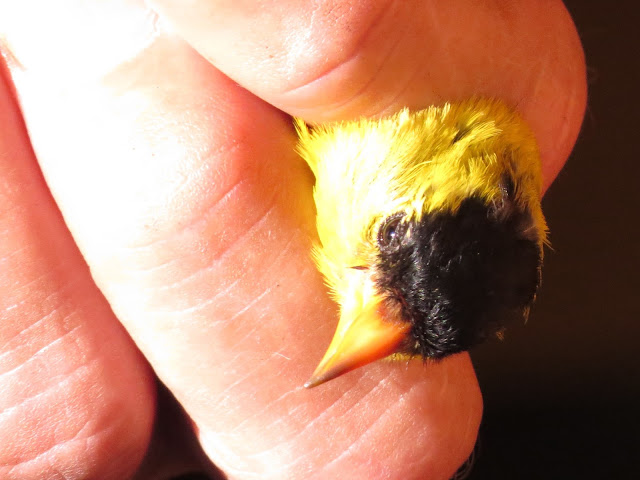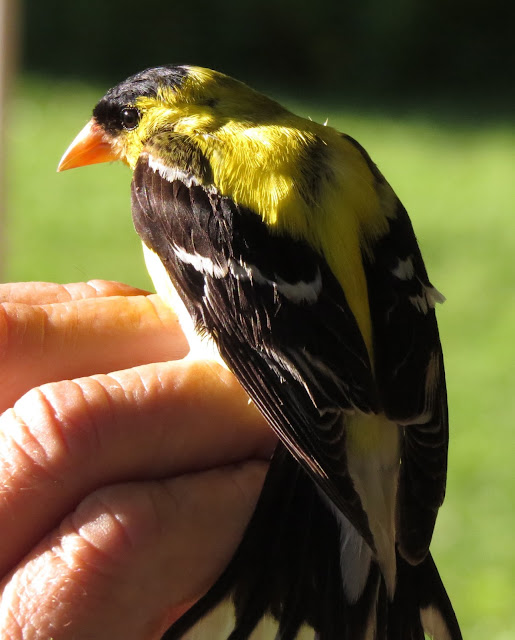Blue sky, sun, light breezes - Perfect for a trip to Audubon Vermont in Huntington for a bird-banding demonstration!
 |
| Mark LaBarr Audubon Vermont's Conservation Biologist |
This is the twentieth year for the Audubon Vermont bird-banding station. Ten mist nets were set out and checked frequently to make sure no bird injures itself. Before becoming a licensed bird bander, Mark had to do a lot of studying and then be vouched for by three master banders. His license allows him to net and band specific species in specific states, and always for the purpose of a scientific study or survey. Mark explained that strict regulations and monitoring are for the birds' protection.
This American Goldfinch weighed a mighty 12.2 grams. The plumage identified it as a male.

This young Swamp Sparrow showed rich chestnut coloring on its wings. Habitat changes on the Audubon property - in particular, the reduction in beaver activity - have resulted in changes in bird life. Swamp Sparrows are becoming more prevalent.
This feisty Red-eyed Vireo latched onto Mark's finger. Three Red-eyed Vireos were banded this morning. This bird's deep red eyes show that it's an adult. One was a female with a "brood patch": a section of the breast that's featherless, so the bird can keep her eggs warm with her body heat.

Metal bands or "bracelets" are placed on one foot, the size of the band depending on the size of the bird.
Mark recently found the large band below on one of the Lake Champlain islands. Using the number on the band, he was able to find out that it had been worn by a Canada Goose.

After each bird is banded, it is weighed, sexed, aged and its wing is measured. Data is sent to a lab in Maryland and added to a huge data bank for use by ornithologists and other scientists.
The wing of this juvenile Gray Catbird measured 90 mm, and the bird weighed 34.9 grams.

A bird's skull can also provide information about its age. As a bird matures, it develops a double skull, the two layers connected by support columns. The positions of these columns show up as little dots on the skull. A bird that hasn't yet developed support columns is a first-year bird.
Banders also look for evidence of wear and molt on the birds' feathers. This male American Redstart has lots of different colors! Some of its wing feathers still show the juvenile yellow coloring while other, newer feathers show adult orange. It's a second-year bird, hatched in summer 2016.
The differing lengths of the redstart's wing feathers show that it's in the process of molting: losing some feathers and growing new ones. Songbirds molt gradually, losing and gaining feathers at different times. (Ducks, by contrast, molt all their feathers at once and can't fly at all for a while.)

This is "the bird-banders' bible". The pages and pages of detailed information help banders determine birds' age, sex, health, stage of molt, and even subspecies.


Very modern high-tech equipment is used in weighing small songbirds! They're placed head down inside a toilet paper roll or a film canister, and then placed on a scale. (Larger birds such as Blue Jays are weighed inside a stocking, using a hanging scale.)

Children and adults alike were fascinated by the birds and very attentive to Mark's clear explanations.
But this little one preferred the tiny frog he was holding.

The bags hold birds that were caught in mist nets and are waiting to be banded, evaluated and released.
For today's banding, Mark LaBarr was assisted by Felicia King and Steven Lamonde.
Mark proudly wears his bird-banders' smock from the British Trust for Ornithology - a Christmas gift from his kids!
A Broad-winged Hawk viewed the banding station with haughty disdain. Mark said the bird is "a regular" and probably nests on the Audubon property.

Audubon hosts many classes and summer school sessions each year. This little girl was learning what she would need to succeed as a bird: feathers, a bill, big feet and talons.
For more information on banding birds:
Why band Birds.
What purpose does bird banding serve?
About Bird Bands.
Vermont Birds and Words

































No comments:
Post a Comment